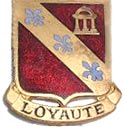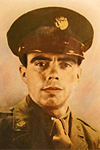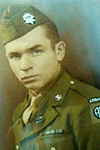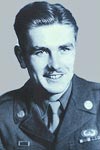

|
The 319th Glider Field Artillery Battalion
Memories
PRESS RELEASE | Feb. 22, 2019
Soldier Accounted For
From World War II (Mills, C.)

WASHINGTON – The Defense POW/MIA Accounting Agency (DPAA) announced today that U.S.Army
Pfc Clifford M Mills, 29, (pictured left) of Troy, Indiana,
killed during World War II, was accounted for on Jan. 29, 2019.
In September 1944, Mills was a member of the 319th Glider Field Artillery Battalion,
82nd Airborne Division, which participated in Operation Market Garden, the invasion of the German-occupied Netherlands.
On Sept. 18, 1944, Mills was reported missing in action in the vicinity of Wyler and Zyfflich, Germany.
Because of enemy control of the area, an immediate search for Mills was not possible.
After the war, the Army found no evidence that Mills had survived the landing or been captured.
Following the end of hostilities, the American Graves Registration Command (AGRC),
U.S. Army Quartermaster Corps, was tasked with investigating and recovering deceased and missing American personnel
in the European Theater. During the course of these operations, units recovered thousands of unknown sets of remains.
One set, designated Unknown X-2566 Neuville, was recovered from an isolated grave near a downed glider. The remains
could not be identified and were subsequently buried as an Unknown at the Henri-Chapelle American Cemetery
and Memorial in Hombourg, Belgium.
Following thorough analysis of military records and AGRC documentation by DPAA historians
and scientists, which suggested a strong association between X-2566 Neuville and Mills, the remains were disinterred
in June 2017 and sent to DPAA for analysis.
To identify Mills’ remains, scientists from DPAA and the Armed Forces Medical Examiner System
used mitochondrial DNA (mtDNA) analysis, dental and anthropological analysis, as well as circumstantial and material
evidence.
DPAA is grateful to the American Battle Monuments Commission for their partnership in this mission.
Of the 16 million Americans who served in World War II, more than 400,000 died during the war.
Currently there are 72,742 service members (approximately 26,000 are assessed as possibly-recoverable) still
unaccounted for from World War II. Mills’ name is recorded on the Walls of the Missing at the Netherlands American
Cemetery in Margraten, Netherlands, an American Battle Monuments Commission site, along with others who are missing
from WWII. Although interred as an "unknown" his grave was meticulously cared for over the past 70 years by the
American Battle Monuments Commission. A rosette will be placed next to his name to indicate he
has been accounted for.
For family information, contact the Army Service Casualty Office at (800) 892-2490.
Mills will be buried March 30, 2019, in Troy, Indiana.
.
For additional information on the Defense Department’s mission to account for
Americans who went missing while serving our country, visit the DPAA website at www.dpaa.mil,
find us on social media at www.facebook.com/dodpaa or call (703) 699-1420.
|
|
PRESS RELEASE | Nov. 25, 2019
Soldier Accounted For
From World War II (Hedtke, W.)

WASHINGTON – The Defense POW/MIA Accounting Agency (DPAA)
announced today that U.S. Army Pvt William D Hedtke, 28, (pictured left) of Iola, Wisconsin,
killed during World War II, was accounted for Oct. 17, 2019.
(This identification was initially published Oct. 25, 2019.)
In 1944, Hedtke was assigned to Battery B, 319th Glider Artillery Battalion, 82nd Airborne Division.
Army officials reported he died of injuries sustained in a hard glider landing near Groesbeek, Netherlands,
during Operation Market Garden on Sept. 18, 1944. His remains were not recovered after the war.
In June 1945, Canadian graves registration personnel recovered a set of American remains near
Groesbeek that were given to the American Graves Registration Command (AGRC). After unsuccessful efforts by the AGRC
to identify the remains, they were designated X-1230 Margraten and interred as an Unknown at the Netherlands American
Cemetery.
In 2016, DPAA disinterred X-1230 to be scientifically analyzed for possible association to an
Operation Market Garden casualty.
To identify Hedtke’s remains, scientists from DPAA used dental and anthropological analysis.
Additionally, scientists from the Armed Forces Medical Examiner System used mitochondrial DNA (mtDNA)
and Y-chromosomal (Y-STR) analysis.
DPAA is grateful to the American Battle Monuments Commission and to the U.S. Army Regional
Mortuary-Europe/Africa for their partnership in this mission.
Of the 16 million Americans who served in World War II, more than 400,000 died during the war.
Currently there are 72,635 service members still unaccounted for from World War II with approximately
30,000 assessed as possibly recoverable. Hedtke’s name is recorded on the Walls of the Missing at
Margraten American Cemetery, an American Battle Monuments Commission site in Margraten, Netherlands,
along with the others missing from WWII. A rosette will be placed next to his name to indicate he has
been accounted for.
For family information, contact the Army Service Casualty Office at (800) 892-2490.
Hedtke will be buried at Arlington National Cemetery in Arlington, Virginia.
The date has yet to be determined. For future funeral information, visit www.dpaa.mil.
For additional information on the Defense Department’s mission to account for
Americans who went missing while serving our country, visit the DPAA website at www.dpaa.mil,
find us on social media at www.facebook.com/dodpaa or call (703) 699-1420.
|
|
Memories of the 319th GFAB
by
Sgt. Mahlon Sebring, A Battery
submitted by Greg Sebring.
 Dad (Sgt. Mahlon Sebring; pictured left)
sat in the co-pilots seat of the CG4A glider going into Holland (Operation Market Garden). He was assigned
there because prior to his enlistment, he worked at the B-24 Liberator plant in Willow Run, MI where he
installed the de-icing boots on the front edge of the stabilizers and some interior wiring. The rational they
used to put Dad in the right seat was they told him you worked on bombers so you have more airplane experience
than anyone else here!!
Dad (Sgt. Mahlon Sebring; pictured left)
sat in the co-pilots seat of the CG4A glider going into Holland (Operation Market Garden). He was assigned
there because prior to his enlistment, he worked at the B-24 Liberator plant in Willow Run, MI where he
installed the de-icing boots on the front edge of the stabilizers and some interior wiring. The rational they
used to put Dad in the right seat was they told him you worked on bombers so you have more airplane experience
than anyone else here!!
On the inbound flight the tow rope between the glider and the C-47 was made out of nylon
and stretched considerably. Coiled around the tow rope was a communication wire that allowed the glider to
talk to the tow plane. My father had the headphones on and when the flak started coming up heavy, the tow
planes increased speed to the point they were flying faster than the loaded gliders were designed for. The
vibrations were shaking the gliders severely. He told the tow pilot to slow down as their airspeed was in
the red and the glider was badly shaking. The pilot responded,"You're coming with us so hang on". A flak shell
burst between them and the tow plane and a piece of it struck the tow rope causing it to unwind a bit.
They were able
to release the tow rope and glide down toward the landing area. Dad said the pilot appeared to freeze up a bit
as they were landing in a field with an approaching tree line and there wasn't enough room to safely land. So,
when Dad saw the pilot not taking corrective action, he grabbed the wheel yoke and pulled it back all the way.
Luckily, they had enough airspeed to climb up over the treeline then stall and sort of pancake into the adjacent
field. Upon landing, the glider was not in trim and side skidded to a stop with the runners cutting a
nice shallow trench before stopping. This was fortunate because it gave them some cover from the Germans who
were spraying the field with machine gun fire.
heir objectives were to secure the bridges at Nijmegen and Grave. The 319th
fired 34,000 rounds of 75mm from their pack howitzers during the Holland campaign and was awarded the "Order
of William" (Orange lanyard) to be worn of their uniforms.
The medals thatwere awarded to my father were all common: ETO campaign ribbon with one
invasion arrowhead and four battle stars, the Good Conduct Medal, an Army of occupation medal with "Berlin"
clasp, and the WWII Victory medal. He qualified for the Purple Heart due to catching some shrapnel in his
butt but never turned the paperwork after treatment to the Aid Station to get credit for it. He said he felt
embarrassed at the time to get a medal for something like that.
In retrospect, he wishes he did receive it as all awards were worth so many points and the
guys with the highest point total got to come home first. Dad made it through the Bulge and crossed the Rhine
near Cologne before meeting the Russians at Ludwigslust. He finished his tour in Berlin harassing the Russians
like you wouldn't believe.
contributed by his son,
Greg Sebring
|
|
More Memories of the 319th GFAB
by
Mike Ingrisano
submitted by Todd Gibson.
My grandfather was part of the 319th Glider Field Artillery Battalion in WW II. In the photo -
my grandfather is the guy holding the machete next to the flag. This is a fairly well-known photo,
used in at least two history books I know of, as well as HBO's "We Stand Alone Together" (Band of Brothers
documentary). In addition, here is a story from a pilot about my grandfather's glider crash in
Operation Market Garden (the author, Mike Ingrisano witnessed the event - small world):
D+1: Monday, September 18, 1944: Glider Tow:
The 316th was led in Serial A-42 by the 37th, chalk numbers 1 through 20, followed by the
44th, chalk numbers 21 through 42. They towed 42 CG-4A gliders which, in addition to the glider pilots, carried
175 troops, 2 photographers, 21 jeeps, two 75mm howitzers 4266 pounds of ammunition and 13532 pounds of
combat equipment.Lift-off from Cottesmore was 1135 hours for the serial's designated LZ (Landing Zone)
just northeast of Groesbeek, Holland.
While on course and about sixteen minutes from the English
coast, the 37th TCS glider number 43-36654, chalk number 6A, piloted by F/O (Flight Officer) Benson J.
Reed became detached from aircraft serial number 43-15509, chalk number 6, piloted by Robert H. Koon.
The glider landed in the English Channel and the glider pilot and five men of the 82nd were picked up
within two minutes by the air-sea rescue service. The glider with its 2075 pounds of equipment,
including a trailer, was not recovered. The tow plane returned to Cottesmore where the pilot and co-pilot
provided the information surrounding the necessity for ditching.
F/O Reed supplied these details of the rescue.
About 30 miles east of Great Yarmouth, the GP reported that he was experiencing
extreme difficulty controlling the glider as it swerved off course at a severe angle. The GP cut loose
from the tow plane. Then only after losing sufficient speed was he able to control his glider.
He brought the glider down at 50 MPH. The tail of the glider hit the water several times and a large wave
swelled directly in front of the glider. Fortunately, since the pilot saw an air-rescue service craft in
the vicinity, the landed close to the craft. The pilot broke through the window on the left side; one
passenger tore a hole through the top; one went out the emergency door and the rest escaped through
the back door. The GP received an abrasion on the lower lip and swelling on his forehead and side of his
head. One passenger suffered a broken nose, another several broken ribs, and the rest were badly shaken
up. Reed returned to Cottesmore on September 20, having lost a pair of OD pants, heavy underwear, jump
jacket, two pairs of socks, helmet, musette bag, one escape kit, a Thompson machine gun, and 45-caliber
pistol. (Intelligence Report of a Ditched Glider, prepared by Lt. Robert Roman Intelligence officer,
37th TCS, Sept. 22, 1944. (Condensed by the writer in Chapter 8, "Market", VALOR WITHOUT ARMS, A HISTORY OF THE 316TH TROOP CARRIER
GROUP, 1942-1945 by Mike Ingrisano).
Lt. John Eskoff, 319th Glider Field Artillery battalion, was on Reed's glider.
He reported that:
Our take-of on D+1 and the flight to the English Channel was uneventful.
The load was well balanced and the air was smooth. Shortly after leaving the shores of England, several British
bombers (Stirlings, I believe, MI), towing gliders, passed under our glider a few hundred feet below.
The prop wash (turbulence) rocked our glider and gave me an uneasy feeling. Suddenly our glider swooped
upward and to the right. I heard a sharp snap and saw the tow rope "going away." The pilot dived out of
formation to clear the way for those following. I had the men remove our equipment and kick off the
emergency doors. I called off air speed and altitude for the pilot. We braced ourselves and landed
head on into a wave at 75 mph. Water filled the compartment immediately. I swam and pulled myself to the
emergency door. When I came up on the outside I saw five heads so I knew that all of us
were out of the glider. A Royal Air Force Sea Rescue launch was pulling up beside us.
We crashed at 1318 hours, 18 miles from the coast of England. By 1330 hours we were all
aboard the rescue launch. Dry clothes, medical attention, hot soup, sandwiches and cigarettes were
furnished. We landed at Yarmouth, England at 2115. One man had been injured slightly.
(THE HISTORY OF THE 319TH GLIDER FIELD ARTILLERY BATTALION, WEDNESDAY SEPTEMBER 13, 1944 TO MONDAY,
OCTOBER 16, 1944. Enclosure number 1.Signed John Eskoff, Lt. 319th Glider FA Bn,
Glider # 6. Also now included in my Chapter 8).
Unfortunately, Lt. Eskoff does not name his crew members.
Incidentally, my aircraft was towing Chalk Number 7, which means that we were leading a two glider
element behind and to the left of #6. SMALL WORLD! I think you will find that your grandfather
went down in the English Channel, heading toward Holland. I may be wrong because it might have been
close to the North Sea.
Hope you enjoy the account. It happened that way. Believe me! Take care!
Mike Ingrisano
|
|
books
R E L A T E D B O O K S
Ambrose, Stephen E D-DAY June 6,1944:
The Climatic Battle of WW II. 6/93, Simon & Shuster ISBN: 0671673343
Badsey , Stephen & Chandler, David G (Editor)
Arnhem 1944:
Operation "Market Garden" (Campaign No.24) 1993
96p. ISBN: 1855323028
Breuer, William B Geronimo! American
Paratroopers in WWII. New York: St. Martin Press, 1989 621 p. ISBN: 0-312-03350-8
Covais, Joseph S Battery: C. Lenton Sartain and the Airborne GIs of the 319th Glider Field Artillery. CreateSpace, 9/2011 586 p. ISBN: 1463578318
D'Este, Carlo
Patton: A Genius for War 1024 pp ISBN: 0060927623
De Trez, Michel
At the Point of No Return : Pictorial History of the American Paratroopers in the
Invasion of Normandy 7/98, D-Day Pub, 200 p. ISBN: 2960017617
Gavin, James M.
On to Berlin : Battles of an Airborne Commander, 1943-1946 ISBN: 0670525170
Golden, Lewis Echoes From Arnhem Penguin
ISBN: 0718305213
Ingrisano, Michael N. Jr And Nothing is Said:
Wartime Letters, August 15, 1943 - April 21, 1945 Sunflower
University Press, Sept 2002, 540p. ISBN: 0897452631
MacDonald, Charles B A Time For
Trumpets: The Untold Story of the Battle of the Bulge Wm Morrow & Co
(P), 720 p. ISBN: 068151574
Masters, Charles J.
Glidermen of Neptune: The American D-Day Glider Attack Southern Illinois Univ Press, ISBN:0809320088
McKenzie, John
On Time, On Target Novato, CA: Presidio, May 15,2000. 304 p. ISBN: 089 141 714 1
Nigl, Dr Alfred J & Charles A Nigl
Silent Wings - Savage Death Santa Ana, CA: Graphic Publishing, Dec 3,2007. 288 p. ISBN: 1882824318
Ryan, Cornelius
A Bridge Too Far 670p. ISBN: 0684803305
Tucker, William H.
"Rendez-vous at Rochelinval" Battle of the Bulge International Airborne Books,Harwichport, MS, ISBN:0-9647683-2-1
Wildman, John B All Americans 82nd
Airborne. Meadowlands Militaria, 6/83 ISBN:091 208 1007
The Center of Military History The War in the Mediterranean: A WWII Pictorial History Brasseys, Inc.,
465 p. ISBN:1574881302
|